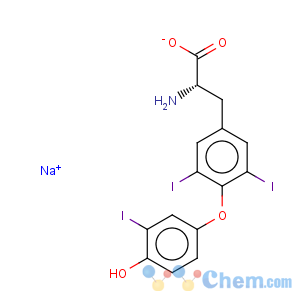Cytomel T3 (Liothyronine Sodium)
-
- Product NameCytomel T3 (Liothyronine Sodium)
- CAS No.55-06-1
- Purity
- Min Quantity
- Price~

 View Contact Detail
View Contact Detail
-
 Molecular Structure
Molecular Structure
Detailed Description
Product Name: Cytomel T3 (Liothyronine Sodium)CAS No.: 55-06-1
Assay: NLT 98.0%
M.F.: C15H11I3NNaO4
M.W: 672.96
Appearance: almost white or buff colored powder
Solubility: Very slightly soluble in water, slightly soluble in alcohol, practically insoluble in most other organic solvents, dissolves in diluted aqueous sodium hydroxide solutions
Identification:
1. Heat about 50 mg with a few drops of sulfuric acid in a porcelain crucible: violet vapors of iodine are evolved.
2. The retention time of the major peak conforms with that of the RS.
Loss on Drying: NMT 4.0%
Specific Rotation: +18 o ~ +22o
Levothyroxine Sodium: NMT 5.0%
Details:
Liothyronine is the most potent form of thyroid hormone. Chemically, it is nearly identical to triiodothyronine (T3). As such, it acts on the body to increase the basal metabolic rate, affect protein synthesis and increase the body's sensitivity to catecholamines (such as adrenaline) by permissiveness. The thyroid hormones are essential to proper development and differentiation of all cells of the human body. These hormones also regulate protein, fat, and carbohydrate metabolism, affecting how human cells use energetic compounds.
In comparison to levothyroxine (T4), liothyronine has a faster onset of action as well as a shorter biological half-life, which may be due to less plasma protein binding to thyroxine-binding globulin and transthyretin.
Physicians can use this instead of or in addition to levothyroxine (T4) for patients undergoing thyroid withdrawal. When a patient has thyroid cancer or Graves' disease, ablation therapy with radioactive iodine can be used to remove any trace thyroid tissue. For 131I therapy to be effective, the trace thyroid tissue must be avid to iodine. The best method is to starve the tissue of iodine but this can lead to hypothyroid symptoms for the patient. Withdrawal from levothyroxine can be done but it takes six weeks of withdrawal for the remaining thyroid tissue to be completely starved. Six weeks is needed owing to levothyroxine's long half life. Six weeks can be inconvenient for the patient and delay treatment. Liothyronine instead can be taken and withdrawn from for two weeks to starve the thyroid tissue. This is much safer and more convenient than levothyroxine.